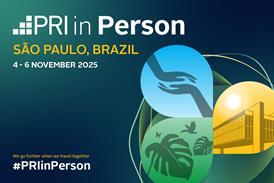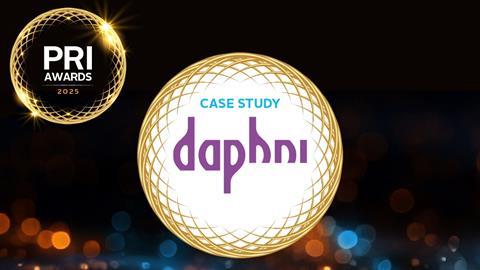PRI Awards 2025 Winning Category: Private Markets Special Award
Organisation: daphni
HQ: France
The approach, initiative or process
Daphni believes that communication is the front line of responsible investing. In a market where sustainability can easily devolve into a compliance check-box or greenwashing exercise, it chooses radical transparency and education instead. Daphni’s strategy in 2024 revolved around a simple but ambitious goal: to make ESG real, understandable and actionable, not only for limited partners (LPs) and founders, but for the entire venture ecosystem.
Daphni’s communication objectives focused on:
-
educating and informing all stakeholders – from institutional investors to first-time founders – about ESG realities in the start-up space;
-
bridging the gap between limited partner (LP) expectations and start-up realities, by translating start-up ESG challenges into tangible, accessible stories;
-
empowering engagement through creativity, storytelling and data that inspires rather than intimidates.
Daphni selected channels and formats not by convention, but by strategic intention:
-
its 2024 ESG report served as its flagship document – deeply analytical yet honest, blending metrics with narratives to humanise ESG impact;
-
an Easy ESG Toolkit (v0), publicly released and modular by design, made ESG implementation accessible to founders at all levels of maturity;
-
dedicated lunches and events for our LPs to grow awareness for them on responsible investments in the venture capital (VC) world;
-
release in open source of our ESG rating tool and methodology;
-
demistifying the Sustainable Finance Disclosure Regulation (SFDR) by relaeasing a 69-page guide on it;
-
a podcast, a newsletter, a 100-page book treating the S, and even six music EPs (on sustainability) that gave voice to founders, investors and community leaders, proving ESG isn’t just for specialists but for everyone;
-
social media (especially LinkedIn) allowed daphni to iterate and engage dynamically, with 437,000+ impressions on impact content alone.
Daphni prioritised ESG themes that are systemic and material: climate action, gender and territorial diversity, data reliability, impact measurement and the responsible use of AI. But crucially, it didn’t treat ESG as an abstraction. Its stories featured real startups, from Back Market to Apiday to Moonwatt, illustrating how ESG shows up in business decisions, technology development, and governance.
Making the complex intelligible
Daphni tackled the complexity of ESG with a multi-layered approach:
-
clear visuals and storytelling: in all reports and public communications;
-
benchmarking and contextualisation of data: e.g. comparing daphni’s carbon footprint against industry norms, or showing how 23 portfolio companies completed carbon assessments;
-
gamification: daphni is developing an ESG engagement scoring system to benchmark startups and spark healthy competition across its portfolio;
-
curated content: daphni shared business case studies (e.g. Costco vs. Target, studies by Skema) to prove ESG can be a value creation play – not a cost;
-
making its conviction heard, even if it can be wrong.
To avoid greenwashing, dapnhi structured its content around what’s provable. That meant:
-
citing sources;
-
showing progress and shortcomings alike;
-
using verified data, often through Apiday, its AI-based ESG data platform;
-
having its Mission Committee, a group of seasoned external experts, review, challenge and validate messaging.
Daphni also designed communications to be inclusive and accessible. The ESG Toolkit, for example, breaks down policies into ‘copy-paste’ blocks with three levels of maturity. This helps non-expert founders take meaningful steps without being overwhelmed. Daphni’s podcast and music formats engage younger, creative audiences who might never read a PRI report.
One of the most pressing challenges daphni has addressed is the disconnect between LPs and start-up realities. It translated start-up ESG practices into LP-ready narratives, showing how its portfolio embeds ESG beyond the policy side. From Climate Dividends distribution by Geev and Fifteen, to Rainbow (our endowment fund), daphni offer LPs visibility into how ESG translates into real-world change.
Lastly, daphni acknowledged a cultural challenge inside VC firms: how to get everyone to care about ESG? daphni’s answer:
-
internal objectives and key results tied to sustainability;
-
a proposed ‘carry ESG’ model to align incentives for everyone;
-
transparent goals (e.g. 60% of new deals include a sustainability clause);
-
ongoing team workshops and internal communications led by daphni’s ESG head.
At daphni, ESG communication is not owned by one person, it’s embedded in the culture, and in 2024, it made that visible to the world. It will even push further in 2025.
Measures to ensure transparency and generate outcomes
Daphni’s ESG communications in 2024 were more than just outputs; they were triggers for engagement, catalysts for learning and proof points of a new way to do venture capital. By putting transparency and storytelling at the heart of its approach, daphni created content that not only reached wide audiences but also reshaped behaviour across the venture ecosystem.
Measurable reach and resonance
Across channels, its communication strategy achieved significant engagement:
-
437,000+ impressions from ESG-related LinkedIn posts, up 23% from 2023;
-
ESG-focused newsletter reached more than 3,000 subscribers with a 38% open rate, well above industry benchmarks;
-
more than 65 posts dedicated to ESG topics, including sustainability-linked investments, diversity and regulatory developments, sparked high-quality comments from founders, investors and peers;
-
66% of its podcast episodes tackled ESG head-on, covering themes like circularity, AI frugality, and sustainable logistics.
This reach translated into real-world recognition. Daphni’s ESG report was shared by other general partners (GPs) as an example of best practice. Multiple LPs cited it in quarterly reviews. Several founders referenced it when preparing their own investor updates, mimicking daphni’s formatting and storytelling structure.
But reach isn’t enough; daphni cares about understanding. That’s why it prioritised formats and language that demystify ESG, such as:
-
case studies with simple explanations;
-
visualised data (e.g. footprint comparisons, scoring scales);
-
first-person quotes from founders about ESG challenges and turning points.
As a result, founders and LPs didn’t just read, they used daphni’s materials.
Real world behaviour change
Daphni saw tangible shifts in founder behaviour and ecosystem alignment in 2024, including:
-
portfolio ESG participation increased from 29 to 52 companies, thanks in part to improved storytelling and educational webinars;
-
more than 10 companies adopted the ESG Toolbox to create or revise their policies, showing uptake of its modular ‘block’ approach to ESG design;
-
ESG is now on the agenda of 64% of boards where daphni has a voting seat, and it intends to drastically increase this number with new materials it created used to structure discussions;
-
founders began speaking out publicly on ESG, inspired by daphni’s storytelling model.
This shows a clear shift from ESG as a compliance task to ESG as a value narrative.
Transparency in practice
True to our values, daphni went further than most in opening the black box of VC ESG. It didn’t just share wins; it also acknowledged limits:
-
it disclosed that only 63% of eligible companies completed a carbon assessment, explaining both the challenges and next steps;
-
it published its own 318 tCO₂e footprint (Scope 1, 2, and 3), assessed through Sami, and contrasted it with its financed emissions;
-
daphni’s Impact Score (63) was benchmarked against the French market (average 54) to provide realistic context, not inflated self-praise;
-
it made these numbers relatable. For instance, in the ESG report, daphni explained how 13,869 tCO₂e financed emissions translates into sector-wide challenges, and highlighted leaders like Back Market and Swile who are actively reducing footprints.
In addition, daphni’s communication was independently validated by:
-
its Mission Committee, which includes ESG experts, climate leaders, and entrepreneurs who challenge assumptions and outputs;
-
Apiday, its AI-based platform for ESG data collection and consistency checks;
-
public and private feedback loops with LPs, founders and peers, including those who requested early access to daphni’s next-gen ESG scoring system.
This transparent, multi-layered validation process ensured that all daphni’s messaging adheres to PRI-aligned best practices, and is factual, contextualised and honest.
From words to action
Daphni’s communications also activated stakeholders in powerful ways:
-
LPs began requesting ESG data earlier in due diligence, not just at year-end, following daphni’s example of regular, high-quality updates;
-
several VCs reused daphni’s ESG maturity model and toolkit in their own portfolio communications, extending its impact across the market.
Investors and founders began adopting Climate Dividends in their communications - a concept daphni has championed since 2022.
In 2025, daphni expects even greater impact as it rolls out its ESG engagement scoring, a gamified benchmarking system that helps founders visualise their sustainability maturity and get inspired by peers. It’s not about shaming low performers; it’s about motivating progress and providing concrete next steps.
Daphni also plans to expand Rainbow, its endowment fund, by offering portfolio-wide ESG education grants and creating an ESG storytelling playbook, a tangible output from this year’s communication learnings.
PRI disclaimer:This case study aims to contribute to the debate around topical responsible investment issues. It should not be construed as advice, nor relied upon. It is written by a guest contributor. Authors write in their individual capacity – posts do not necessarily represent a PRI view. The inclusion of examples or case studies does not constitute an endorsement by PRI Association or PRI signatories.












